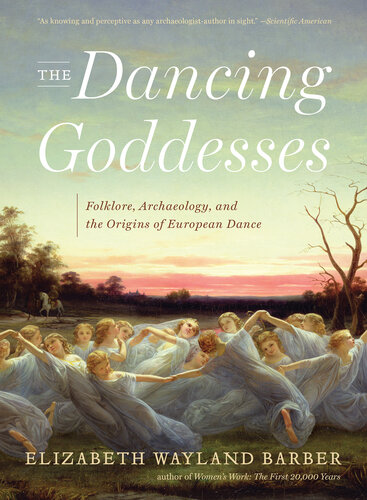
The Dancing Goddesses
Folklore, Archaeology, and the Origins of European Dance
کتاب های مرتبط
- اطلاعات
- نقد و بررسی
- دیدگاه کاربران
نقد و بررسی

November 5, 2012
Traditions of dance and folklore have long been tied to changing seasons and agricultural cycles, and so too have women been linked throughout history to the fertility of the natural world. Basing her investigation on linguistics, archeological evidence, and folklore itself, Barber (Women's Work) explores how the relationship between dance and women has developed over the ages in Europe. She explains that the advent of calendars and holidays were initially intended to aid in agrarian planning; then she focuses on the women who were celebrated and revered during these holidays. They took the form of fairies, mermaids, nymphs, and more, and in their ritual incarnationâwhether in art or performanceâthey were ornamented in silks, skirts, beads, and flora, and could curse or bless the upcoming agricultural season. Rich with anecdotes and compelling explanations of the origin of many modern customs (such as throwing rice at a bride), Barber's is an informative and amusing read, often bringing together many diverse sourcesâtraditional stories, illustrations of artifacts, and aspects of popular cultureâinto an illuminating whole that will serve as a nice introduction for those unfamiliar with the topic, and a valuable reference for scholars of European dance and folklore. 150 illus. and photos, 9 maps.

May 1, 2013
The dancing goddesses of the title are the swan maidens, mermaids, and tree-spirits that would eventually morph into the "wilis" of the ballet Giselle, the Rusalka of Dvorak's eponymous Czech opera, and the black and white swans of the ballet Swan Lake. Barber (archaeology & linguistics, emerita, Occidental Coll.; The Mummies of Urumchi), a lifelong folk dancer, explores the origins of dance in this analysis of the folk customs and cultures of Albania, Bosnia, Bulgaria, Croatia, Hungary, Russia, Serbia, Ukraine, and more. She also investigates the sources of a number of folk customs, such as rituals connected with celebrations of the solstice, weddings, childbirth, and initiations to adulthood. Her research material includes an array of books and articles in various Slavic languages, and her website (elizabethwaylandbarber.com) provides full translations of many of these texts that could only be quoted or summarized in the book. VERDICT Dance historians and students of folklore and archaeology will find much to consider in this scholarly work. An impressive study that weaves together dance, folklore, culture, and mythology.--Carolyn M. Mulac, Chicago P.L.
Copyright 2013 Library Journal, LLC Used with permission.

























دیدگاه کاربران